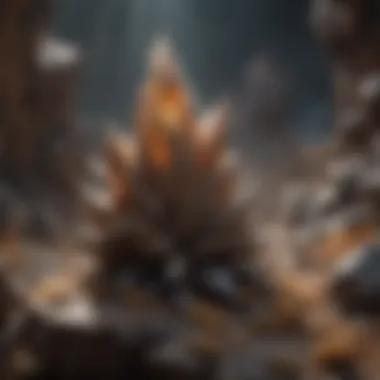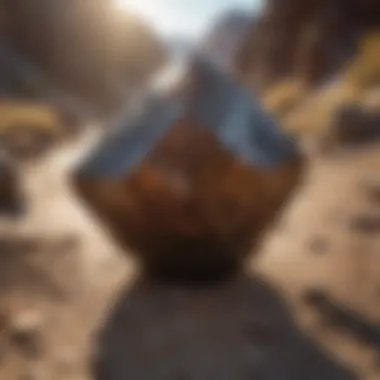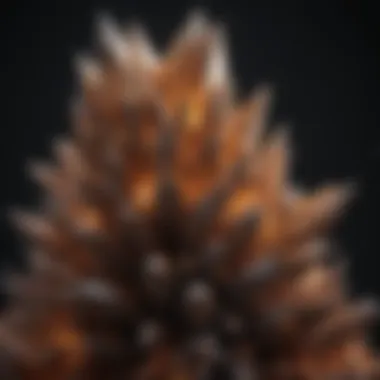Unveiling the Enigmatic Beauty of Staurolite: A Geological Marvel That Intrigues


Rock and Fossil Identification
Staurolite, a compound mineral of aluminum, iron, and silicon, is a focal point in the realm of geological wonders. Known for its remarkable cross-shaped crystals, staurolite intrigues enthusiasts and experts alike. Its distinctive crystalline structure and earthy tones make it a prized addition to any collection. When seeking to identify staurolite, keep an eye out for these defining characteristics: the cruciform shape of its crystals, ranging in color from brown to reddish-brown, and its hardness, typically scoring around 7-7.5 on the Mohs scale. To aid in identification, tools such as a geologist's hammer, hand lens, and streak plate can be instrumental in examining the mineral's physical properties and structure.
Collecting Tips and Techniques
For avid collectors drawn to the allure of staurolite, mastering the art of retrieval is essential. Prime collecting sites often include metamorphic rock outcrops and mineral-rich locations where staurolite occurs naturally. To safely extract specimens, a chisel, protective goggles, and sturdy gloves are recommended. Exercise caution when conducting fieldwork to avoid damaging both the mineral and its surrounding environment. Implementing best practices, such as documenting the locality and adhering to land regulations, ensures a fulfilling and ethical collecting experience.
Preservation and Display
Upon acquiring staurolite specimens, proper preservation techniques are vital to maintain their integrity and beauty. Methods such as wrapping the mineral in protective padding, storing it in a dry environment away from direct sunlight, and avoiding exposure to harsh chemicals help prolong its lifespan. When it comes to display, creativity abounds – from sleek glass cases to custom-built shadow boxes, there are various ways to showcase the enchanting allure of staurolite. Selecting a display method that highlights its unique features and complements its surroundings elevates the visual impact of this geological marvel.
Geological Insights
Beyond its aesthetic appeal, staurolite offers profound insights into geological processes and history. The mineral's formation within metamorphic rocks sheds light on the transformative forces at play beneath the Earth's surface. Studying staurolite's prevalence in specific geological formations unveils intricate narratives of our planet's evolution over millennia. Noteworthy discoveries in the field, from rare crystal configurations to significant staurolite deposits, continue to deepen our geological understanding and appreciation for this enigmatic mineral.
Introduction to Staurolite
Staurolite, a mineral of profound geological significance, serves as a captivating subject of exploration in this article. Its unique properties and formation processes make it a compelling focus for both enthusiasts and experts in the field. From its intriguing crystal structures to its diverse applications, Staurolite remains a topic of perpetual fascination among rock and fossil collectors seeking to delve deeper into the world of geological wonders.
Origins and Discovery
Historical Significance
Delving into the historical significance of Staurolite unveils a rich tapestry of narratives that highlight its importance in the realm of geology. Its discovery and role in ancient civilizations provide unparalleled insights into the evolution of mineralogy and the cultural value ascribed to this enigmatic gem. Exploring the historical context of Staurolite not only enriches our understanding of geological history but also adds layers of complexity to its contemporary relevance, making it a valuable addition to the discourse on rock formations and earth sciences.
Geological Occurrence
Understanding the geological occurrence of Staurolite is pivotal in appreciating its widespread distribution and formation processes. From rare occurrences in specific regions to more abundant deposits in others, the spatial distribution of Staurolite offers valuable clues about the earth's geological past. Examining the geological contexts in which Staurolite thrives sheds light on the intricate mechanisms that govern its formation and provides a nuanced perspective on the mineral's role in shaping the earth's crust over millennia.
Crystal Structure
Cross-like Formation
The cross-like formation of Staurolite crystals is a defining feature that sets this mineral apart from others in its class. With distinctive geometric patterns reminiscent of sacred symbols, Staurolite's crystal structure embodies a harmonious blend of symmetry and elegance. The intricate formation process behind these cross-like crystals adds a layer of mystique to Staurolite, making it a prized possession for collectors and researchers alike.


Composition
Analyzing the composition of Staurolite offers valuable insights into its physical properties and chemical characteristics. Comprising a unique blend of elements, Staurolite's composition plays a crucial role in determining its color, hardness, and overall visual allure. Understanding the chemical makeup of Staurolite not only deepens our appreciation for its aesthetic value but also paves the way for innovative applications in various industrial sectors that seek to harness its intrinsic qualities.
Physical Characteristics
Color Variations
The diverse color variations exhibited by Staurolite crystals add a touch of vibrancy to its overall aura, ranging from earthy browns to rich shades of red and yellow. These color variations not only enhance the visual appeal of Staurolite specimens but also offer valuable insights into their mineralogical origins. By unraveling the mysteries behind Staurolite's color palette, collectors and researchers can gain a deeper understanding of its formation processes and historical significance within the geological landscape.
Hardness and Luster
The hardness and luster of Staurolite crystals underscore their durability and visual brilliance, making them sought-after additions to mineral collections worldwide. With a remarkable hardness that ensures long-lasting beauty and a luster that reflects light with unparalleled radiance, Staurolite stands as a testament to nature's artistic precision. Exploring the intricate details of Staurolite's hardness and luster not only elevates our admiration for this geological marvel but also highlights its practical applications in various fields requiring resilient and aesthetically pleasing materials.
Formation Process
Staurolite's formation process is a critical aspect of this article, shedding light on the intricate journey this mineral undergoes to come into existence. Understanding the formation process provides profound insights into the geological forces at play, unraveling the mystery behind the unique characteristics of staurolite. By delving into the conditions and transformations the mineral experiences during its formation, we gain a deeper appreciation for its enigmatic beauty and geological significance.
Conditions for Staurolite Formation
Pressure and Temperature
Exploring the dynamic interplay between pressure and temperature is paramount in comprehending how staurolite forms. The precise balance of these factors influences the crystal structure and quality of staurolite, determining its durability and visual appeal. By studying the effects of varying pressure and temperature ranges on staurolite formation, we can unravel the mechanisms that shape this geological marvel, offering a holistic view of its intricate gestation process.
Metamorphic Environments
Investigating the role of different metamorphic environments in staurolite formation provides valuable insights into its unique properties. Each distinct environment, whether it be regional metamorphism or contact metamorphism, imparts specific characteristics to the staurolite crystals, contributing to their diversity and allure. By understanding how metamorphic environments influence staurolite formation, we can appreciate the geological forces at work and the significance of these environments in shaping the Earth's crust.
Transformation Journey
Mineralogical Changes
The mineralogical changes that staurolite undergoes during its transformation journey offer a fascinating glimpse into the dynamic processes that mold its final form. These changes, driven by geological forces and chemical interactions, result in the distinctive properties that define staurolite, such as its crystal clarity and color variations. By dissecting the mineralogical changes occurring within staurolite, we gain a deeper understanding of its geological origins and the complexities involved in its metamorphic evolution.
Factors Influencing Growth
Examining the various factors that influence staurolite's growth is essential to unraveling its enigmatic beauty. From chemical compositions to external pressures, each factor plays a significant role in determining the size, shape, and quality of staurolite crystals. By elucidating the influence of these factors on staurolite growth, we can appreciate the intricate interplay of nature's forces in sculpting this geological marvel, offering a nuanced perspective on its formation and evolution.


Distinctive Features
Staurolite is a mineral of tremendous geological interest due to its distinctive features, particularly its formation of cross-shaped crystals which are both rare and visually striking. These unique crystals have captivated scientists and collectors alike, offering insights into the mineral's growth process and environment. The significance of these distinctive features lies in their role as identifiers of staurolite specimens, setting them apart from other minerals and highlighting their geological importance.
Twinning Phenomenon
The twinning phenomenon in staurolite manifests in two primary forms - Penetration Twins and Carlsbad Twins. These twin structures contribute significantly to our understanding of staurolite's crystallography and growth patterns, shaping the mineral's overall appearance and structural characteristics.
Penetration Twins
Penetration Twins in staurolite are a remarkable aspect of its crystal structure, showcasing intersecting crystals that penetrate each other at specific angles. These twins play a crucial role in identifying staurolite samples and studying the mineral's symmetry and internal arrangements. The key characteristic of Penetration Twins is their distinct geometric formation, creating intricate patterns within the crystal lattice. This unique feature provides valuable insights into staurolite's crystalline behavior and the forces at play during its formation.
Carlsbad Twins
On the other hand, Carlsbad Twins in staurolite exhibit a parallel intergrowth of crystal individuals, resulting in a twin structure with characteristic mirror symmetry. These twins offer a different perspective on staurolite's crystal twinning phenomena, emphasizing the mineral's structural versatility and symmetry variations. The unique feature of Carlsbad Twins lies in their parallel arrangement, allowing researchers to explore the mineral's twinning habits and internal growth processes with precision.
Inclusions and Impurities
Staurolite often contains inclusions and impurities, adding further complexity to its composition and affecting its physical properties. Two notable aspects in this regard are Garnet Inclusions and Iron Content Influence, which play significant roles in shaping staurolite's appearance and characteristics.
Garnet Inclusions
Garnet Inclusions within staurolite specimens introduce flashes of color and texture, creating intriguing visual contrasts within the crystal structure. These inclusions enhance the aesthetic appeal of staurolite samples, making them highly sought after by collectors and gem enthusiasts. The key characteristic of Garnet Inclusions is their ability to infuse staurolite crystals with vibrant hues and intricate patterns, elevating their overall visual charm and market value.
Iron Content Influence
The Iron Content Influence in staurolite impacts the mineral's color intensity and hardness, adding another layer of complexity to its chemical composition. High iron content can imbue staurolite crystals with deep reddish-brown tones and increase their resistance to abrasion, making them suitable for a range of industrial applications. Understanding the influence of iron content is crucial for assessing staurolite's quality and potential uses, shedding light on the mineral's versatility and durability in various settings.
Geological Significance
Staurolite holds immense geological significance due to its role as an indicator of metamorphism and the valuable insights it provides into the Earth's history. By analyzing staurolite-bearing rocks, geologists can determine the metamorphic grade, which is a critical parameter in understanding the intensity of metamorphic processes that have shaped a particular region. This mineral's presence helps in mapping the zoning patterns of metamorphic terranes, offering vital clues about the geological evolution of an area. Through the study of staurolite, researchers can decipher the complex underground processes that have transformed rocks over millions of years.
Indicator of Metamorphism
Metamorphic Grade
The metamorphic grade indicated by staurolite signifies the degree of metamorphic recrystallization a rock has undergone. This measure is crucial for assessing the temperature and pressure conditions prevailing during metamorphism, providing a comprehensive view of the geological forces at play. Staurolite's characteristic formation at specific grade levels aids geologists in gauging the depths at which rocks were buried and the subsequent uplift they experienced. Understanding these metamorphic grades enhances our knowledge of the tectonic movements and buried geologic events that have shaped the Earth's crust.
Zoning Patterns
Zoning patterns observed in staurolite-bearing rocks illustrate the variations in metamorphic conditions and geological processes within a region. These distinctive patterns help geologists delineate different metamorphic zones and infer the sequences of events that led to their formation. By studying these zoning patterns, researchers can unravel the chronological progression of metamorphic activities and ascertain the temporal relationships between various rock layers. The presence of staurolite in specific zones can indicate the thermal and pressure history of an area, enhancing our understanding of the dynamic changes that have sculpted the Earth's crust.
Regional Variation
Global Distribution
The global distribution of staurolite showcases its occurrence in diverse geological settings worldwide, shedding light on the mineral's adaptability to different tectonic environments. Through analyzing staurolite occurrences across continents, geologists can discern subtle variations in mineral assemblages and interpret the tectonic histories of various regions. This widespread distribution offers a rich tapestry of geological information, enabling researchers to draw parallels between distant terranes and unveil the shared geological processes that have shaped the Earth's surface.
Notable Deposits
Examining the notable deposits of staurolite unveils concentrated occurrences of this mineral in specific geological settings, providing valuable insights into the geological conditions conducive to its formation. By studying these deposits, geologists can deduce the factors leading to prolific staurolite growth and investigate the mineralogical mechanisms governing its crystallization. Notable deposits serve as geological archives, preserving the conditions under which staurolite thrives and offering a glimpse into the ancient environments where this enigmatic mineral flourished. Understanding these localized deposits enhances our comprehension of staurolite's geological significance and its role in illuminating Earth's intricate history.
Practical Applications
Staurolite, with its remarkable properties, finds diverse applications that highlight its significance in various industries. This section unveils the practical versatility of this geological marvel, shedding light on how its unique characteristics benefit different sectors. From abrasive purposes to ceramic industry utilization, staurolite's role is multifaceted and essential. The in-depth exploration of its applications underscores the indispensable nature of this mineral.
Utilization in Industry
Staurolite's practical uses in industry are profound and extensive, catering to specific needs and requirements within various sectors. Two noteworthy areas where staurolite plays a pivotal role are abrasive purposes and the ceramic industry.
Abrasive Purposes
Discussing its contribution to abrasive purposes, staurolite's exceptional hardness and durability make it a preferred choice in the abrasive industry. Its unique structure allows for effective grinding and cutting, providing precision and efficiency in various applications. Highlighting the benefits of staurolite in abrasive processes and examining its advantageous properties showcase why it stands out as a top choice for this essential function.
Ceramic Industry
Exploring staurolite's utilization in the ceramic industry reveals its significance in enhancing ceramic products' quality and performance. The distinct characteristics of staurolite contribute to the strength and aesthetic appeal of ceramics, making it a popular additive in ceramic production. Evaluating the advantages and potential drawbacks of integrating staurolite into ceramic manufacturing processes unveils its impact on the industry's output and overall quality.
Collectors' Perspectives
Staurolite's allure extends to collectors who appreciate its beauty and rarity, emphasizing its value beyond industrial applications. This section dives into collectors' perspectives, examining the market value and importance of preserving staurolite specimens for future generations.
Collector's Market Value
Delving into the collector's market value of staurolite, one can discern the factors that contribute to its desirability among collectors. Its unique crystal formations and scarcity in nature elevate its worth in the eyes of collectors, adding a dimension of exclusivity to staurolite specimens. Analyzing the advantages and potential limitations of investing in staurolite specimens offers insights into the intricacies of the collector's market.
Specimen Preservation
The importance of specimen preservation in the world of staurolite collectors cannot be understated. Preserving specimens ensures their integrity and longevity, safeguarding their beauty and scientific value for years to come. Highlighting the techniques and considerations involved in specimen preservation sheds light on the meticulous efforts dedicated to maintaining the quality and allure of staurolite specimens within collections.







